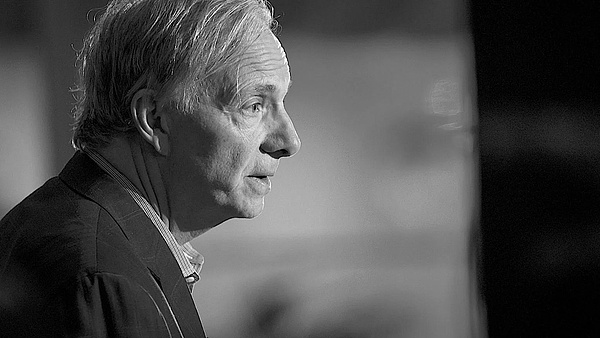
Author: Ray Dalio, Founder of Bridgewater Associates
Ray Dalio's Investment Philosophy Introduction for 2025
If you want to succeed in the coming years, especially in a rapidly changing world, the primary and most fundamental principle is:understand reality and base your decisions on reality, not your wishes. Most people's mistake is viewing investments through recent experiences or personal biases. This is a dangerous approach to the market, especially at this stage of long-term debt and political cycles. We are at a historic turning point in economic, geopolitical, and technological terms.Interest rates are no longer zero, inflation has not disappeared, geopolitical tensions are escalating, productivity growth is no longer guaranteed, and the U.S.-dominated unipolar world order familiar to many investors is being challenged. In such times, old formulas become ineffective, and the environment requires investors to become students of history and systems.
[The rest of the translation follows the same pattern, maintaining the original structure and translating all text while preserving the <> tags]Importantly, we have entered a phase where traditional monetary policy (adjusting interest rates) is insufficient. Therefore, fiscal policy intervenes, with government borrowing and spending attempting to maintain growth. But when the government borrows while the central bank simultaneously prints money, it leads to debt monetization. This is not an academic concept, but has real consequences: it devalues currency, drives up inflation, forces people away from cash and bonds, increases volatility, and could even lead to a loss of confidence in the system itself.
Therefore, one cannot expect to repeat the patterns of the past decade in 2025. The rules are changing, bonds no longer offset stock risks as before, and long-term bonds may be one of the most dangerous places during sustained or accelerating inflation. Cash seems safe, but it is quietly losing value when actual returns are negative. Investors need to understand the mechanisms of money creation, debt repayment, and government responses to pressure. This is not just theoretical, but practical: it explains why inflation hedging is important, why geographic and asset class diversification is no longer optional, and why resilience matters more than chasing returns. If you cannot see the stages of the debt cycle, you will be caught off guard. But if you see and adapt accordingly, you will be ahead of others. This is how to gain an advantage by aligning with the deep structural forces shaping the economy, rather than just following headlines.
The Transformation of Global Order and Its Investment Implications
Investors' biggest mistake is believing that diversification means holding many different assets. They buy stocks, some bonds, a few international stocks, thinking they are diversified. But deeper analysis reveals these assets are highly correlated during stress periods. This is not diversification, but disguised concentration. In today's world of increasing volatility and institutional changes, such an allocation is dangerous.
True diversification is not holding different assets, but holding assets that perform well in different economic environments. The global economy operates in cycles, driven by two primary forces: growth and inflation. This creates four basic environments:
Rising growth + rising inflation
Rising growth + falling inflation
Falling growth + rising inflation
Falling growth + falling inflation
Each asset class performs differently in these environments. An ideal portfolio maintains balance across all four: holding assets that perform well during prosperity (like stocks), in inflationary environments (like commodities, inflation hedges, or certain real estate), during weak growth (like high-quality government bonds), and assets that provide protection against tail risks (like gold or safe-haven currencies).
What you are designing is balance, not betting on a single environment, but preparing for all. This reduces volatility, protects downside risks, and allows you to compound consistently through cycles. Most investors do not do this because they focus too much on recent performance, chasing strategies that just worked. This is a mistake. Markets constantly change, and what was effective yesterday may fail tomorrow. True diversification is like a well-functioning machine, where each part has a different purpose but operates harmoniously overall. When one part underperforms, another compensates. This is the magic of true diversification—it not only reduces risk but increases returns by keeping you invested and stable amid uncertainty.
In 2025, with potential inflation resurgence, central bank experiments, and geopolitical tensions that could trigger sudden volatility, you need a portfolio not dependent on a single outcome. Because the reality is, no one knows exactly how the future will unfold. But we can construct a portfolio that will not be destroyed regardless of which path the world takes. This is how you transition from speculation to strategy, how you stay in the game long-term. In an uncertain world, this is not just a good idea, but necessary.
Bridgewater's Strategy for the Upcoming Market Cycle
[The translation continues in the same manner for the remaining text, maintaining the original structure and emphasis while translating to English.]We are entering a period of intensifying geopolitical tensions, economic inequality fueling populism, and institutional trust collapse. These forces not only shape news cycles but also reshape the rules of the game. If governments become desperate due to high debt, inflation, or unrest, they will take all necessary measures to protect themselves. This could mean increasing wealth taxes, adding capital controls, changing the treatment of certain investments, or even restricting capital flows. If you haven't factored in these risks, you are exposed.
Therefore,geographical diversificationis more important than ever—not just in asset location, but also in legal systems, governments, and currencies. Portfolios concentrated in a single jurisdiction are vulnerable to policy changes in that jurisdiction. You might think your capital is safe, but if rules change overnight, you may not be able to access, transfer, or avoid punitive taxation. Investing is not just about investing in companies or markets, but also aboutinvesting in systems. Some systems are more stable, transparent, and investor-friendly. You need to consider the robustness of the rule of law, institutional independence, the possibility of political turmoil, and the trajectory of public debt. These are not academic issues, but practical factors that determine asset safety.
In 2025, as government debt increases and political divisions deepen, the temptation for governments to shift burdens to the private sector will grow. This could mean wealth taxes, transaction taxes, unrealized gains taxes, or restrictions on overseas holdings. If you are not prepared for such an environment, your vulnerability is not because investments are bad, but because the environment has changed. The solution is not to panic, but toprepare—think globally, hold assets in different jurisdictions, diversify currency exposure, understand economic and political stress points, and allocate accordingly. In a world where risks are not just economic but systemic, the ability to protect and grow wealth depends not only on market choices but also onstructural choices.
Ray Dalio's Principle of Diversification
The most successful investors I have studied or worked with are not successful because they always get things right, but because they areprepared to be wrong. This principle is hard to accept, especially in a world that worships belief and confidence. But beliefs without humility are the root of market disasters. The truth is, no one knows exactly what the future will look like. The world is too complex, with too many variables and dynamic interactions. Therefore, instead of trying to always be right, build a system that can survive, or even thrive, when wrong.
Most people start from the self, tying their identity to their views. When their views are challenged or proven wrong, they double down or deny. This is vulnerability, not strength. The true power in investing is knowing that being wrong is part of the game and designing methods accordingly. This meanscontinuously stress-testing assumptions, asking yourself "What if I'm wrong?" with every action, and setting up protections for inevitable errors.
Here, the concept ofasymmetryis crucial. You want to position yourself so that upside potential far exceeds downside risk—earning a lot when right and losing little when wrong. This is not by chance, but by design, the result of thoughtful positioning, risk control, and humility. The best portfolios are not based on predictions, but onprobabilities. You must continuously consider a range of scenarios, not just the one you think is most likely. Markets do not reward certainty, butadaptability, and adaptability begins with acknowledging that the future is unknowable, and the best response is balance, flexibility, and openness to new information.
In 2025 and beyond, this mindset is especially important. We live in a world of rising complexity, political instability, technological disruption, debt burdens, climate events, and social pressures. Any of these could trigger a shift in the entire landscape. Therefore, instead of trying to predict the next big move, prepare for multiple outcomes. Build anall-weather portfoliothat does not depend on a single environment, can withstand shocks, and continue compounding. Humility is not a weakness, but a strength rooted in reality, the foundation of resilience.
Final Advice for Every Long-Term Investor
The world will bring surprises, and mistakes are inevitable. The question is whether you are prepared to learn and grow from them, or let them push you out of the game. In investing,survivalis underestimated. Those who are thoughtful, cautious, and strategically stay in the game long-term are the ultimate winners.
Conclusion: Preparing for the New World Economy
In a world full of uncertainty, debt burdens, geopolitical shifts, and rapidly changing economic systems, the path forward for investors is not through prediction, but throughpreparation. Success belongs to those rooted in reality, who smartly diversify across environments and jurisdictions, precisely manage correlations and risks, and always remain humble enough to acknowledge they might be wrong. It's not about betting on what you hope will happen, but about building a resilient strategy that can withstand whatever comes. In such times,survival is strength, and resilience is the true advantage.







